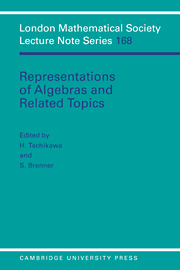Book contents
- Frontmatter
- Contents
- Introduction
- Homologically finite subcategories
- Global generatedness version of rings of pure global dimension zero
- Projective resolutions and degree shifting
- Modules of finite length over their endomorphism rings
- Pairs of semi-simple algebras (hereditary algebras with radical-square zero)
- The module theoretical approach to quasi-hereditary algebras
- Matrix problems, small reduction and representations of a class of mixed Lie groups
- Classification problems for modular group representations
- Lie algebras (arising in representation theory)
Matrix problems, small reduction and representations of a class of mixed Lie groups
Published online by Cambridge University Press: 05 August 2013
- Frontmatter
- Contents
- Introduction
- Homologically finite subcategories
- Global generatedness version of rings of pure global dimension zero
- Projective resolutions and degree shifting
- Modules of finite length over their endomorphism rings
- Pairs of semi-simple algebras (hereditary algebras with radical-square zero)
- The module theoretical approach to quasi-hereditary algebras
- Matrix problems, small reduction and representations of a class of mixed Lie groups
- Classification problems for modular group representations
- Lie algebras (arising in representation theory)
Summary
In representation theory of Lie groups the cases of reductive and solvable groups are highly elaborated (cf. [K]). Much less seems to be known about mixed groups, i.e. those neither reductive nor solvable. Moreover, the simplest examples (cf. §1) show that in a sense the complete description of their representations is a hopeless problem. Nevertheless, in some cases it turns out to be possible to describe “almost all” of them in a rather appropriate way (cf. theorem 1.2), namely, they behave just like representations of a reductive group.
This lecture is an account of the author's joint work with A. Timoshin [DT] where we managed to apply to the investigation of representations of some mixed groups the method of so-called “matrix problems” which enabled us to obtain such an answer.
Thus, the lecture splits into two parts. The first (§§1–3) contains the formulation of the main theorem (theorem 3.1) with necessary preliminaries and its reduction to a matrix problem. The second part (§§4–6) is devoted to matrix problems which we treat in terms of representations of bocses (cf. [R]) and culminates in §6 with the proof of the main theorem. The most technical, but to my mind also the most important, is §5 where we present an algorithm elaborated in [BGOR]. I think that the importance of this algorithm (called “small reduction”) is still far from being properly appreciated.
I am grateful to S. Ovsienko for friendly and fruitful discussions which were of great use to me, and to A. Timishin for his kind permission to use our joint results in this talk.
Information
- Type
- Chapter
- Information
- Representations of Algebras and Related Topics , pp. 225 - 249Publisher: Cambridge University PressPrint publication year: 1992
Accessibility standard: Unknown
Why this information is here
This section outlines the accessibility features of this content - including support for screen readers, full keyboard navigation and high-contrast display options. This may not be relevant for you.Accessibility Information
- 2
- Cited by
